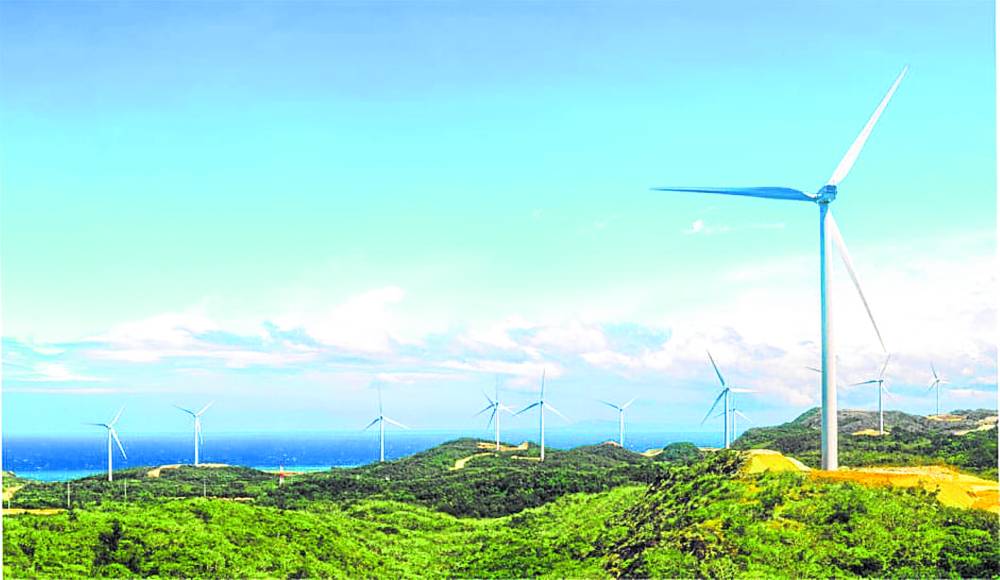A review of decarbonization initiatives in the Philippines

HARNESSING WIND The 150-megawatt wind farm of EDC Burgos Wind Power Corp. in Ilocos Norte is the largest in the country. —photo from First Gen Corp. website
Listed Philippine companies are gradually integrating strategies that take action on climate change. However, choosing which path or solution to integrate can be challenging given the complexity of climate change. Climate change is complex because its causes and effects are tied to human activities and the global economy, and management is always faced with a tradeoff.
Do we target the cause: increased greenhouse gases, or do we address the effects of climate change—a long list of potential disasters like flooding, food shortage, droughts, etc.? In our review of sustainability reports over the past three years, the preferred strategy is to combat the rise of carbon emissions. While we see decarbonization still in their initial stages, there has been a significant shift to emphasize the reduction of the carbon footprints of many companies.
There are several ways by which decarbonization strategies are being integrated and it can be varied across industries. For some, decarbonization entails investing in renewable energy (RE) production or consumption while others prefer carbon capture initiatives such as tree-planting activities.
The use of RE in energy consumption is gradually growing and we have observed that property companies have been leading the charge in this space. A good portion of this improvement has come from the installation of solar panels on top of the roof decks of some malls. While we cannot specifically identify how much energy is consumed by malls, we do observe some mall developers increasing RE consumption from low single-digit levels to high double-digit percentages.
The use of solar panels to augment energy consumption is only one aspect of RE consumption in companies we have reviewed. Purchasing RE from the open access is now becoming more prevalent based on sustainability disclosures. Office-centric property developers and real estate investment trusts (REITs) have reported some buildings at 100-percent RE usage, purchasing electricity from RE sellers under the open access system.
Article continues after this advertisementThis may be driven by demand from sustainabilty-centric tenants since it is not true across all office assets. Nevertheless, it signals to the property industry that demand for green energy from high-value tenants is increasing, and it’s a source of potential competitive advantage since RE supply is limited in the near-term and availability may not be feasible in areas where transmission reach is challenging.
Article continues after this advertisementThis means that the power industry needs to accelerate its development of RE assets to meet rising demand. We see the shift to RE across all conglomerates that have power in their portfolio. Some have invested outside the Philippines while others have committed to local RE. Nevertheless, the capacity growth targets for RE are encouraging.
Energy security
The road for RE is still being paved. While solar is clearly a preferred platform today, companies are already investing in alternative technologies such as wind and batteries or studying the feasibility of others, such as hydrogen and tidal/wave energy. The important point is that the power industry recognizes the need for energy security and the urgency of reducing carbon emissions.
RE is critical to decarbonization but it also presents a challenge amid the need for energy security. In this energy puzzle, banks play a role in putting a price tag for decarbonization. Most of the large banks are supportive of RE with the issuance of sustainable bonds and via financing green projects. These projects lead to the avoidance of carbon emissions.
However, given our generating capacity is 35-percent powered by coal, to achieve substantial decarbonization, this may require gradually reducing exposure or exiting from coal as an energy source. Banks managing access to capital for coal power and mining companies have been tagged as a catalyst for decarbonization. However, less than a handful of banks have affirmed commitments to reducing loan exposure to coal generation assets within a set period. There is no regulatory requirement or timetable set for banks to exit coal, for now.
Coal power plants, despite their climate impact, provide baseload or stable capacity, a quality that some RE technologies cannot replace. A transition from fossil-fuel based energy sources to RE requires a phased approach. In the meantime, coal-based companies may opt for clean energy alternatives such as liquified natural gas (LNG) in the medium-term while the Philippines decarbonizes its energy mix.
Balanced approach
Lastly, RE is not the only action companies can take. Telecommunication firms provide examples of complementary approaches to decarbonization. One telco partnered with a foundation that engages in long-term tree-planting activities, which is a carbon-capture approach. This means for every ton of carbon emission produced, the firm can offset a portion with carbon captured by the tree. However, effective carbon-capture requires that the tree grows and survives to maturity. This is why a partnership with a forester or forest specialist is critical to this strategy.
Since telcos are heavy capital-expenditure companies, some take on a capital cost approach to decarbonization. They have studied their respective cost of capital to incorporate carbon risks. If successful, telcos can contribute and participate in emerging carbon markets, particularly if one were to be established in the Philippines. We believe carbon markets will be the future in helping regulate carbon emissions and incentivize the adoption of clean energy, RE and green technologies.
In the near term, we see the emphasis on decarbonization to continue, particularly in the area of RE. The current energy crisis that highlights energy security will encourage more investments to reduce exposure to the volatility of energy markets. That being said, as investors, we advocate a more balanced approach to climate action. Companies should consider carbon pricing, carbon-capture activities, and just as important, the integration and allocation of capital for climate resilience and disaster management. —CONTRIBUTED
Jose Mari Lacson is head of macroeconomics and sustainability research at ATR Asset Management.